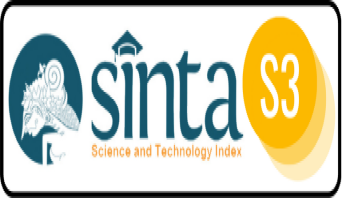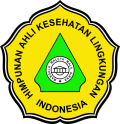TINJAUAN FAKTOR YANG MEMPENGARUHI KUALITAS AIR PADA SISTEM RAIN WATER HARVESTING (RWH)
DOI:
https://doi.org/10.26630/rj.v15i1.2178Keywords:
Rainwater harvesting, quality, pollutants, treatmentAbstract
The increase in population due to the birth rate has put pressure on meeting the water needs of the people. In 2050, the global demand for clean water is to meet the needs of 9.7 billion people. One of the strategies developed for sustainable water use is rainwater harvesting (RWH). From many reports, the RWH system can meet household water needs. However, it needs special attention from the quality aspect due to pollution. This paper presents the factors affecting water quality in the RWH system through three stages. The first stage is when rainfall clears pollutants in the air. In the second stage, the rain removes dirt and particles in the catchment area—the third, flushing dirt on pipes and storage tanks. Maintenance must be done to all parts of the RWH system periodically and must be treated and disinfection before being used as drinking water.Â
References
Abdulla, F.A., Al-Shareef, A.W., 2009. Roof rainwater harvesting systems for household water supply in Jordan. Desalination 243, 195–207.
Adugna, D., Jensen, M.B., Lemma, B., Gebrie, G.S., 2018. Assessing the potential for rooftop rainwater harvesting from large public institutions. International Journal of Environmental Research and Public Health 15.
Ahmad, T., Danish, M., 2018. Prospects of banana waste utilization in wastewater treatment: A review. Journal of Environmental Management 206, 330–348.
Ahmed, W., Gardner, T., Toze, S., 2011. Microbiological Quality of Roof-Harvested Rainwater and Health Risks: A Review. Journal of Environmental Quality 40, 13–21.
Aikawa, M., Kajino, M., Hiraki, T., Mukai, H., 2014. The contribution of site to washout and rainout: Precipitation chemistry based on sample analysis from 0.5 mm precipitation increments and numerical simulation. Atmospheric Environment 95, 165–174.
Amodio, M., Catino, S., Dambruoso, P.R., de Gennaro, G., Di Gilio, A., Giungato, P., Laiola, E., Marzocca, A., Mazzone, A., Sardaro, A., Tutino, M., 2014. Atmospheric Deposition: Sampling Procedures, Analytical Methods, and Main Recent Findings from the Scientific Literature. Advances in Meteorology 2014, 1–27.
Bae, S., Maestre, J.P., Kinney, K.A., Kirisits, M.J., 2019. An examination of the microbial community and occurrence of potential human pathogens in rainwater harvested from different roofing materials. Water Research 159, 406–413.
Baguma, D., Loiskandl, W., Darnhofer, I., Jung, H., Hauser, M., 2010. Knowledge of measures to safeguard harvested rainwater quality in rural domestic households. Journal of Water and Health 8, 334–345.
Balla, D., Papageorgiou, A., Voutsa, D., 2014. Carbonyl compounds and dissolved organic carbon in rainwater of an urban atmosphere. Environmental Science and Pollution Research 21, 12062–12073.
Bashar, M.Z.I., Karim, M.R., Imteaz, M.A., 2018. Reliability and economic analysis of urban rainwater harvesting: A comparative study within six major cities of Bangladesh. Resources, Conservation and Recycling 133, 146–154.
Casado, H., Encinas, D., Lacaux, J.P., 1996. Relationship between the atmospheric particulate fraction and the ionic content of precipitation in an area under influence of a waste incinerator located in the Basque country (Spain). Atmospheric Environment 30, 1537–1542.
Charlson, R.J., Rodhe, H., 1982. Factors controlling the acidity of natural rainwater. Nature 295, 683–685.
Cizmecioglu, S.C., Muezzinoglu, A., 2008. Solubility of deposited airborne heavy metals. Atmospheric Research 89, 396–404.
Domènech, L., SaurÃ, D., 2011. A comparative appraisal of the use of rainwater harvesting in single and multi-family buildings of the Metropolitan Area of Barcelona (Spain): Social experience, drinking water savings and economic costs. Journal of Cleaner Production 19, 598–608.
Egodawatta, P., Thomas, E., Goonetilleke, A., 2009. Understanding the physical processes of pollutant build-up and wash-off on roof surfaces. Science of The Total Environment 407, 1834–1841.
Faragò, M., Brudler, S., Godskesen, B., Rygaard, M., 2019. An eco-efficiency evaluation of community-scale rainwater and stormwater harvesting in Aarhus, Denmark. Journal of Cleaner Production 219, 601–612.
Franklin, L.J., Fielding, J.E., Gregory, J., Gullan, L., Lightfoot, D., Ponanski, S.Y., Vally, H., 2009. An outbreak of Salmonella Typhimurium 9 at a school camp linked to contamination of rainwater tanks. Epidemiology and Infection 137, 434–440.
Garcia-Montoya, M., Bocanegra-MartÃnez, A., Nápoles-Rivera, F., Serna-González, M., Ponce-Ortega, J.M., El-Halwagi, M.M., 2015. Simultaneous design of water reusing and rainwater harvesting systems in a residential complex. Computers and Chemical Engineering 76, 104–116.
Garcia Soler, N., Moss, T., Papasozomenou, O., 2018. Rain and the city: Pathways to mainstreaming rainwater harvesting in Berlin. Geoforum 89, 96–106.
Gunawardena, J., Egodawatta, P., Ayoko, G.A., Goonetilleke, A., 2013. Atmospheric deposition as a source of heavy metals in urban stormwater. Atmospheric Environment 68, 235–242.
Gurung, T.R., Sharma, A., 2014. Communal rainwater tank systems design and economies of scale. Journal of Cleaner Production 67, 26–36.
Hamilton, K.A., Ahmed, W., Palmer, A., Sidhu, J.P.S., Hodgers, L., Toze, S., Haas, C.N., 2016. Public health implications of Acanthamoeba and multiple potential opportunistic pathogens in roof-harvested rainwater tanks. Environmental Research 150, 320–327.
Hamilton, K.A., Ahmed, W., Toze, S., Haas, C.N., 2017. Human health risks for Legionella and Mycobacterium avium complex (MAC) from potable and non-potable uses of roof-harvested rainwater. Water Research 119, 288–303.
Hart, C., White, D., 2006. Water quality and construction materials in rainwater catchments across Alaska. Journal of Environmental Engineering and Science 5, S19–S25.
Helmreich, B., Horn, H., 2009. Opportunities in rainwater harvesting. Desalination 248, 118–124.
Huston, R., Chan, Y.C., Chapman, H., Gardner, T., Shaw, G., 2012. Source apportionment of heavy metals and ionic contaminants in rainwater tanks in a subtropical urban area in Australia. Water Research 46, 1121–1132.
Jamali, B., Bach, P.M., Deletic, A., 2020. Rainwater harvesting for urban flood management – An integrated modelling framework. Water Research 171, 115372.
Kaushik, R., Balasubramanian, R., Dunstan, H., 2014. Microbial Quality and Phylogenetic Diversity of Fresh Rainwater and Tropical Freshwater Reservoir. PLoS ONE 9, e100737.
Kemenkes, R.I., 2017. Peraturan Menteri Kesehatan Republik Indonesia Nomor 32 Tahun 2017 Tentang Standar Baku Mutu Kesehatan Lingkungan Dan Persyaratan Kesehatan Air Untuk Keperluan Higiene Sanitasi, Kolam Renang, Solus Per Aqua dan Pemandian Umum, Kemenkes RI.
Kisakye, V., Van der Bruggen, B., 2018. Effects of climate change on water savings and water security from rainwater harvesting systems. Resources, Conservation and Recycling 138, 49–63.
Konikow, L.F., Kendy, E., 2005. Groundwater depletion: A global problem. Hydrogeology Journal 13, 317–320.
Koplan, J.P., Deen, R.D., Swanston, W.H., Tota, B., 1978. Contaminated roof-collected rainwater as a possible cause of an outbreak of salmonellosis. Journal of Hygiene 81, 303–309.
Kristianto, H., 2017. The Potency of Indonesia Native Plants as Natural Coagulant: a Mini Review. Water Conservation Science and Engineering 2, 51–60.
Kuta, G., Emigilati, M., Hassan, A., Ibrahim, I., 2014. Domestic water sources and its health implication in Lapai Local Government area, Niger State, Nigeria. Ethiopian Journal of Environmental Studies and Management 7, 686.
Lee, J.Y., Bak, G., Han, M., 2012. Quality of roof-harvested rainwater - Comparison of different roofing materials. Environmental Pollution 162, 422–429.
Lee, J.Y., Yang, J.S., Han, M., Choi, J., 2010. Comparison of the microbiological and chemical characterization of harvested rainwater and reservoir water as alternative water resources. Science of the Total Environment 408, 896–905.
Lee, K.E., Mokhtar, M., Mohd Hanafiah, M., Abdul Halim, A., Badusah, J., 2016. Rainwater harvesting as an alternative water resource in Malaysia: Potential, policies and development. Journal of Cleaner Production 126, 218–222.
Leong, J.Y.C., Chong, M.N., Poh, P.E., Hermawan, A., Talei, A., 2017. Longitudinal assessment of rainwater quality under tropical climatic conditions in enabling effective rainwater harvesting and reuse schemes. Journal of Cleaner Production 143, 64–75.
Li, Z., Boyle, F., Reynolds, A., 2010. Rainwater harvesting and greywater treatment systems for domestic application in Ireland. Desalination 260, 1–8.
Macomber, P.S.H., 2001. Guidelines on Rainwater Catchment Systems for Hawaii. Hawai.
Mahmoud, N., Hogland, W., Sokolov, M., Rud, V., Myazin, N., 2018. Assessment of rainwater harvesting for domestic water supply in palestinian rural areas. In: MATEC Web of Conferences.
Mays, L.W., 2013. Groundwater Resources Sustainability: Past, Present, and Future. Water Resources Management 27, 4409–4424.
Mendez, C.B., Klenzendorf, J.B., Afshar, B.R., Simmons, M.T., Barrett, M.E., Kinney, K.A., Kirisits, M.J., 2011. The effect of roofing material on the quality of harvested rainwater. Water Research 45, 2049–2059.
Morales-Pinzón, T., Lurueña, R., Rieradevall, J., Gasol, C.M., Gabarrell, X., 2012. Financial feasibility and environmental analysis of potential rainwater harvesting systems: A case study in Spain. Resources, Conservation and Recycling 69, 130–140.
Morselli, L., Olivieri, P., Brusori, B., Passarini, F., 2003. Soluble and insoluble fractions of heavy metals in wet and dry atmospheric depositions in Bologna, Italy. Environmental Pollution 124, 457–469.
Musayev, S., Burgess, E., Mellor, J., 2018. A global performance assessment of rainwater harvesting under climate change. Resources, Conservation and Recycling 132, 62–70.
Naddeo, V., Scannapieco, D., Belgiorno, V., 2013. Enhanced drinking water supply through harvested rainwater treatment. Journal of Hydrology 498, 287–291.
Nalwanga, R., Muyanja, C.K., McGuigan, K.G., Quilty, B., 2018. A study of the bacteriological quality of roof-harvested rainwater and an evaluation of SODIS as a suitable treatment technology in rural Sub-Saharan Africa. Journal of Environmental Chemical Engineering 6, 3648–3655.
Nawaz, M., Han, M.Y., Kim, T. il, Manzoor, U., Amin, M.T., 2012. Silver disinfection of Pseudomonas aeruginosa and E. coli in rooftop harvested rainwater for potable purposes. Science of the Total Environment 431, 20–25.
Nnaji, C.C., Mama, N.C., 2014. Preliminary Assessment of Rainwater Harvesting Potential in Nigeria: Focus on Flood Mitigation and Domestic Water Supply. Water Resources Management 28, 1907–1920.
Oludairo, O., Aiyedun, J., 2016. Contamination of Commercially Packaged Sachet Water And The Public Health Implications: An Overview. Bangladesh Journal of Veterinary Medicine 13, 73–81.
Ozeki, T., Koide, K., Kimoto, T., 1995. Evaluation of Sources of Acidity in Rainwater Using a Constrained Oblique Rotational Factor Analysis. Environmental Science & Technology 29, 1638–1645.
Palla, A., Gnecco, I., La Barbera, P., 2017. The impact of domestic rainwater harvesting systems in storm water runoff mitigation at the urban block scale. Journal of Environmental Management 191, 297–305.
Rahaman, M.F., Jahan, C.S., Mazumder, Q.H., 2019. Rainwater harvesting: Practiced potential for Integrated Water Resource Management in drought-prone Barind Tract, Bangladesh. Groundwater for Sustainable Development 9, 100267.
Reed, R.H., 1997. Solar inactivation of faecal bacteria in water : the critical role of oxygen. Letters in Applied Microbiology 24, 276–280.
Şahin, N.İ., Manioğlu, G., 2019. Water conservation through rainwater harvesting using different building forms in different climatic regions. Sustainable Cities and Society 44, 367–377.
Sánchez, A.S., Cohim, E., Kalid, R.A., 2015. A review on physicochemical and microbiological contamination of roof-harvested rainwater in urban areas. Sustainability of Water Quality and Ecology 6, 119–137.
Santos, S.M. dos, de Farias, M.M.M.W.E.C., 2017. Potential for rainwater harvesting in a dry climate: Assessments in a semiarid region in northeast Brazil. Journal of Cleaner Production 164, 1007–1015.
Sazakli, E., Alexopoulos, A., Leotsinidis, M., 2007. Rainwater harvesting, quality assessment and utilization in Kefalonia Island, Greece. Water Research 41, 2039–2047.
Semaan, M., Day, S.D., Garvin, M., Ramakrishnan, N., Pearce, A., 2019. Optimal sizing of rainwater harvesting systems for domestic water usages: A systematic literature review. Journal Pre-proof 106192.
Shaheed, R., Wan Mohtar, W.H.M., El-Shafie, A., 2017. Ensuring water security by utilizing roof-harvested rainwater and lake water treated with a low-cost integrated adsorption-filtration system. Water Science and Engineering 10, 115–124.
Shittu, 2015. Development of rainwater harvesting technology for securing domestic water supply in Ibadan, Nigeria. International Research Journal of Engineering Science, Technology and Innovation 04, 32–37.
Taiwo, A.S., Adenike, K., Aderonke, O., 2020. Efficacy of a natural coagulant protein from Moringa oleifera (Lam) seeds in treatment of Opa reservoir water, Ile-Ife, Nigeria. Heliyon 6, e03335.
Tamaddun, K., Kalra, A., Ahmad, S., 2018. Potential of rooftop rainwater harvesting to meet outdoor water demand in arid regions. Journal of Arid Land 10, 68–83.
Thomas, T., 1998. Domestic water supply using rainwater harvesting. Building Research and Information 26, 94–101.
UN, 2020. World Population Prospects 2019: Highlights | United Nations [WWW Document]. United Nation. URL https://www.un.org/en/desa/world-population-prospects-2019-highlights (accessed 12.19.20).
Varghese, J., Jaya, D.S., 2008. Drinking water quality assessment of rain water harvested in ferrocement tanks in Alappuzha District, Kerala (India). Journal of environmental science & engineering 50, 115–20.
Vialle, C., Busset, G., Tanfin, L., Montrejaud-Vignoles, M., Huau, M.C., Sablayrolles, C., 2015. Environmental analysis of a domestic rainwater harvesting system: A case study in France. Resources, Conservation and Recycling 102, 178–184.
Wang, Q., Wang, X., Ding, X., 2014. Rainwater trifluoroacetic acid (TFA) in Guangzhou, South China: Levels, wet deposition fluxes and source implication. Science of The Total Environment 468–469, 272–279.
Waso, M., Khan, S., Khan, W., 2018. Microbial source tracking markers associated with domestic rainwater harvesting systems: Correlation to indicator organisms. Environmental Research 161, 446–455.
Wurthmann, K., 2019. Assessing storage requirements, water and energy savings, and costs associated with a residential rainwater harvesting system deployed across two counties in Southeast Florida. Journal of Environmental Management 252, 109673.
Zhao, Y., Wang, Xiuyan, Liu, C., Wang, S., Wang, Xihua, Hou, H., Wang, J., Li, H., 2019. Purification of harvested rainwater using slow sand filters with low-cost materials: Bacterial community structure and purifying effect. Science of the Total Environment 674, 344–354.
Zhu, J. jun, Yu, L. zhong, Xu, T. le, Wei, X., Yang, K., 2019. Comparison of water quality in two catchments with different forest types in the headwater region of the Hun River, Northeast China. Journal of Forestry Research 30, 565–576.
Zhu, K., Zhang, L., Hart, W., Liu, M., Chen, H., 2004. Quality issues in harvested rainwater in arid and semi-arid Loess Plateau of northern China. Journal of Arid Environments 57, 487–505.
Zushi, Y., Masunaga, S., 2009. First-flush loads of perfluorinated compounds in stormwater runoff from Hayabuchi River basin, Japan served by separated sewerage system. Chemosphere 76, 833–840.
Downloads
Published
How to Cite
Issue
Section
License
Copyright (c) 2021 Ruwa Jurai: Jurnal Kesehatan Lingkungan

This work is licensed under a Creative Commons Attribution-NonCommercial 4.0 International License.

Ruwa Jurai: Jurnal Kesehatan Lingkungan is licensed under a Creative Commons Attribution-NonCommercial 4.0 International License.
Authors who publish with this journal agree to the following terms:
- Authors retain copyright and grant the journal right of first publication with the work simultaneously licensed under a Creative Commons Attribution-Non Commercial License that allows others to share the work with an acknowledgment of the work's authorship and initial publication in this journal.
- Authors are able to enter into separate, additional contractual arrangements for the non-exclusive distribution of the journal's published version of the work (e.g., post it to an institutional repository or publish it in a book), with an acknowledgment of its initial publication in this journal.
- Authors are permitted and encouraged to post their work online (e.g., in institutional repositories or on their website) prior to and during the submission process, as it can lead to productive exchanges, as well as earlier and greater citation of published work.

 Â Â Â
   







